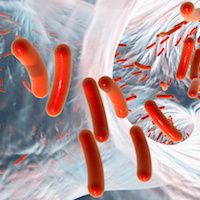Article
Hypervirulent Strain of Clostridium difficile Suggests Evaluating Biomarkers
Author(s):
A new case report shows that isolates obtained from a single patient carry different resistance loci.

A new case report, led by Marina Munoz and Milena Camargo, PhD candidates in Microbiology and Immunology at Del Rosario University in Bogotá, Colombia, explored community acquired Clostridium difficile infection (CA-CDI) and the relationship between antibiotic resistance, molecular toxicity, and hypervirulent CDI.
Munoz, Camargo, and colleagues claim that this study is the first report of community acquired-CDI in Colombia associated with hypervirulent strains showing that isolates obtained from a single patient can carry different toxin and antibiotic resistance loci.
The case study suggests that it’s necessary to evaluate biomarkers associated with specific CDI cases in order to better identify the strain of CDI to determine patient response to treatment.
The case study focuses on the importance of understanding and categorizing various strains of Clostridium difficile (C diff.), and suggests there is a continued global need to characterize different C. diff strains and infection patterns as a means to guide treatment selection and predict outcomes for individual patients infected with C. diff.
The case report, conducted on a 30-year-old woman with community-acquired CDI, provided valuable information on the toxigenic profile, biomarkers, and specific isolates associated with a hypervirulent strain of antibiotic resistant C. diff.
CDI is a global health issue, and as such there’s a globally accepted typing strategy for C. diff strains housed within a public multilocus sequence typing (MLST) database.
The database offers practical application for clinicians, pathologists, and epidemiologists, allowing them to identify specific strains of C. diff from gene markers and their locations. The database is critical for understanding different virulence factors associated with the various strains of C. diff as well as variations associated with antibiotic resistance through mutations. The database can also provide identification for identifying specific toxins.
These toxins encoded by genes located in a chromosomal region called the locos of pathogenicity (PaLoc) are responsible for the presentation of sometimes life-threatening symptoms of CDI.
The subject of the case study, a 30-year-old woman who had been admitted to the emergency room due to a cat bite, received 5 days of antibiotic treatment with ampicillin/sulbactam. Post-treatment the patient reported persistent diarrhea and was treated for a parasitic infection with metronidazole.
When the diarrhea worsened despite metronidazole treatment, a stool sample tested positive for CDI using 2 methods: a Stool DNA Isolation Kit, and in-vitro culture. DNA was then extracted from 7 colony isolates in order to compare them against the MLST database.
Data showed that all isolates belonged to strain type-1 (ST-1) clade 2 which is associated with a hypervirulent strain of C. diff known as 027/BI/NAP1. The researchers also determined the toxigenic profile of the C. diff strain using PaLoc and binary toxin loci (CtdLoc) sequences to target major toxins and their isolates.
Antibiotic resistance in this case study was determined by the identification of polymorphisms in the gyrA and gyrB genes which signal quinolone resistance, as well as identification of markers associated with resistance to other antibiotics. These factors were identified in different samples from the same patient, signaling a need for testing multiple isolates from the same individual.
Identifying the strain of CDI and the nature of the antibiotic resistance in this case study allowed for successful treatment of the patient's particular strain through nutritional management.
Munoz and Carmargo write that during the last 15 years, the increase in the impact of CDI reported has been attributed to the plasticity of its genome, suggesting that the emergence and dispersion of hypervirulent strains of CDI may be attributed to genomic plasticity as well.
The data collected on the specific hypervirulent strain allows for a broader epidemiological profile for the strains, where they could be present in asymptomatic carriers.
"Differential identification of the molecular markers evaluated (associated with both toxins and antibiotic resistance) in these isolates, confirm the importance of evaluating different isolates from a single patient," Munoz and Carmago write.
According to the case report, evaluating these isolates allows for determination of toxigenic potential and antibiotic resistance which can be miss-determined by conventional diagnostic methods leading to inadequate treatment for patients with CDI.
Munoz and Carmargo advocate for the implementation of molecular tests that characterize the specific C. diff strains, relevant loci, and toxins in order to design more effective treatments for these infections.
"Community-acquired infection with hypervirulent Clostridium difficile isolates that carry different toxin and antibiotic resistance loci: a case report" appears in the Nov. 2017 issue of Gut Pathogens.
Related Coverage
Bezlotoxumab, A Cost-Effective Option for At-Risk C. difficile Patients





